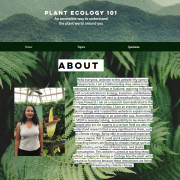Informational Interview with Dr. Miguel Vega-Sanchez, Regulatory Affairs Pipeline Strategy Manager, Insect Control and Genome Editing at Bayer
By Jonathan Lombardino, Conviron Scholar
Perhaps for some of you the looming prospect of where your career as a research scientist will take you has been a daunting and stressful thought-process. Lucky for us, I have enlisted the help of Dr. Miguel Vega-Sanchez, a scientist whose diverse career path has given him a unique perspective to help guide our future career decisions. Below is a brief background of Dr. Vega-Sanchez’s education and work history.
Dr. Vega-Sanchez’s interest in plant science, like many of us, began while conducting research for his undergraduate thesis. Interestingly, his thesis research was studying population genetics of Phytophthora infestans in potato and tomato isolates at a nonprofit organization called the international potato center (CIP) in Quito, Ecuador (headquartered in Lima, Peru, CIP had a research station in Ecuador, Miguel’s home country). Dr. Vega-Sanchez eventually would go on to obtain his PhD in plant molecular biology and biotechnology at Ohio State, where he researched a programmed cell death pathway in rice through molecular genetic analysis and lesion-mimic suppressor mutants screens. Soon after graduating in 2008 Dr. Vega-Sanchez realized he would need to differentiate himself in his field. Around that time, the DOE was pushing hard for research into bio-fuels, and Dr. Vega-Sanchez found himself hired at a bio-energy lab in California funded by the Department of Energy.
Later on in his career, Dr. Vega-Sanchez was accepted into the emerging leaders in science (ELS) program at Monsanto (now Bayer) where he was given the opportunity to rotate one job every year for three years. After his rotations, he realized that Monsanto was the perfect fit for his career interests. Realizing he was fascinated in product strategy and development. Pursuing his interest in the R&D side of the company, Dr. Vega-Sanchez now manages the development of the early regulatory strategies for Bayer’s Plant Biotechnology pipeline products. His day-to-day typically involves working with product development scientists to ensure their work aligns with the company’s strategy for regulatory approval of insect control and genome editing products. Clearly, Dr. Vega-Sanchez has led a diverse career path and was kind enough to share with me some of his takeaways from his different jobs over the years.
Here is my summary of our talk.
On the freedom to pursue your own research:
Conducting research in academia means you are able to set your own course. Once you specialize in a certain area of research, you choose the pathway you want your research to go. If grants continue to come in, you are able to pursue your research based on your interests. In other words, you aren’t that limited in the scope of your research and have the freedom to study something deeper. However, that freedom is limited in an industry setting.
Research in industry is tied to work that has business value and that work is contingent upon what the company wants to promote and develop at a given time. If a researcher finds an interesting result that they would like to investigate further but that work doesn’t align with the business, then there are limitations on pursuing that line of work.
On the resources available in different career paths:
With companies like Bayer garnering so much expertise, working for them feels almost like being in a giant university, where every colleague is a collaborator sharing a common goal. While there is collaboration in academia, that collaboration is usually very siloed. In contrast, in industry you can leverage multiple networks and resources, where other’s expertise is only a phone call or email away. But, in academia its tough because the resources to conduct research are always tied to the lab’s funding, and grant writing takes a considerable amount of time and energy. Success rates writing grants are low and that can be a very challenging and even daunting task. However large companies, like Bayer, can invest up to $1.5 billion every year for research and development, but that doesn’t seem like such a hefty price when there’s a considerably high return on investment.
On the other hand, Dr. Vega-Sanchez highlighted some of the challenges associated with performing research for a nonprofit organization stem from a lack of adequate resources. Working in developing countries coincides with limited resources, reagents, and equipment that most likely need to be imported. Most of us are used to ordering kits for an experiment whose delivery is only days away, but for a lab in a developing country this can take weeks to even months and the momentum of research slows considerably as a result. Furthermore, another challenge with working in a nonprofit setting is acclimating to the fact that your work is tied up in the politics of funding and intervention from governmental bureaucracy, especially when you want to influence change.
On the importance of leadership and interdisciplinary research:
When Dr. Vega-Sanchez joined his bioenergy lab to conduct research on plant cell wall remodeling, he was presented the unique challenges of neither him nor his PI were very experienced in researching the subject. Essentially, he had to reinvent itself. While other labs had begun working with dicot model systems, Miguel and his team worked on Monocots but had a really good model system with lots of genetic resources. To Dr. Vega-Sanchez, this career experience was a great opportunity to build his leadership and problem-solving skills as he essentially helped build a program from scratch. Because of his hard work Miguel eventually was promoted to Co-PI of his lab, where he wrote several grants and managed the program he had helped to build. Not only did Dr. Vega-Sanchez’s time at the DOE give him an incredible leadership experience, but he was also given the freedom to form his own interdisciplinary collaborations with chemical engineers, biophysicists and analytical chemists. Which Dr. Vega-Sanchez describes almost like a startup in an academic setting. In fact, he attributes these early career experiences as the reason he was such a standout candidate for the emerging leaders in science program at Monsanto.
On Job Security and Career Development:
In academia, job security is good considering the tenure system. However, there is no such system in place in industry. If the company experiences a bad year there will obviously be potentials for cuts and layoffs. This is ultimately a source of uncertainty in your job security when your work is tied to the success of the company.
However, working in an industry position is a great place to experience career development. For Dr. Vega-Sanchez, working at Bayer gave him the freedom to change roles in the company through the emerging leaders program. If you want to become an expert in an aspect of the science go for it, but if you want breath that option is also available. By being able to change positions and rotate, he gained a breadth of perspective to grow and advance his career. In fact, like academia, there is plenty of teaching that occurs in a career in industry. Many companies like Bayer are committed to mentoring and coaching younger scientist and staff to promote great research and groom employees to be better advocates for plant science and the company. For instance, Bayer reinvests a considerable amount of money for employee training, courses, and education.
I would like to personally thank Dr. Miguel Vega-Sanchez for taking time out of his busy schedule to setup this interview. Thanks to Dr. Vega-Sanchez’s reflections on his own past experiences, I feel much more comfortable with making decisions for my own future career path.






